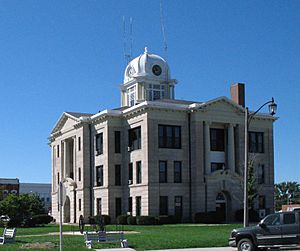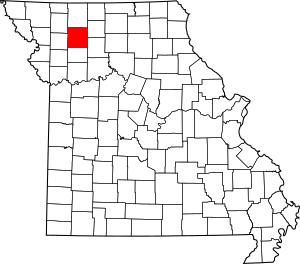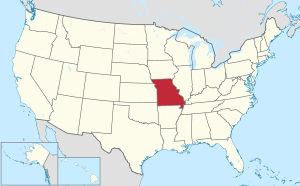Daviess County, Missouri facts for kids
Quick facts for kids
Daviess County
|
|
|---|---|

Daviess County Courthouse in Gallatin
|
|

Location within the U.S. state of Missouri
|
|
 Missouri's location within the U.S. |
|
| Country | |
| State | |
| Founded | December 29, 1836 |
| Named for | Major Joseph Hamilton Daviess |
| Seat | Gallatin |
| Largest city | Gallatin |
| Area | |
| • Total | 569 sq mi (1,470 km2) |
| • Land | 563 sq mi (1,460 km2) |
| • Water | 5.8 sq mi (15 km2) 1.0% |
| Population
(2020)
|
|
| • Total | 8,430 |
| • Estimate
(2021)
|
8,399 |
| • Density | 14.815/sq mi (5.720/km2) |
| Time zone | UTC−6 (Central) |
| • Summer (DST) | UTC−5 (CDT) |
| Congressional district | 6th |
| Website | https://www.daviesscountymo.gov |
Daviess County is a county in the state of Missouri. In 2020, about 8,430 people lived here. Its main town, or county seat, is Gallatin. The county was created on December 29, 1836. It was named after Major Joseph Hamilton Daveiss, a soldier from Kentucky. He was known for his bravery and died in a battle in 1811.
Daviess County is also home to Jamesport. This town has the largest Amish community in all of Missouri. The Amish are a group of people known for their simple way of life.
Contents
Exploring Daviess County's Past
Early Settlements and Beliefs
Long ago, a religious leader named Joseph Smith said that a place called Adam-ondi-Ahman was in Daviess County. He believed this was where Adam and Eve went after leaving the Garden of Eden. Many people who follow the Latter Day Saint movement believe this spot will be important in the future.
The Mormon War in Daviess County
In 1838, many Mormon settlers moved to Daviess County. This happened two years after the county was formed. Some non-Mormon residents worried they would lose control. They tried to stop Mormons from voting in Gallatin. This event led to the first fight in what became known as the Mormon War.
Later, some Mormons reacted to violence against their families. They also faced damage to their property. As a result, they burned and looted several towns. These included Gallatin, Grindstone Fork, and Millport. Millport was the biggest town and a trade center at the time. It never recovered and became a ghost town. The governor of Missouri, Lilburn Boggs, then ordered the Mormons to leave the state.
The James-Younger Gang's Connection
Daviess County also has a link to the famous outlaw James-Younger Gang. The first confirmed bank robbery by Jesse James happened here. It was on December 7, 1869, at the Daviess County Savings Association in Gallatin. Later, on July 15, 1881, the gang was thought to have robbed a train in Winston.
After Jesse James died, his brother Frank James gave himself up in 1882. He faced charges in Daviess County for the train robbery and the 1869 bank robbery. Frank James's trial was held in the Gallatin Opera House. It was so popular that many people came to watch. He was found not guilty of the crimes.
Today, the Daviess County Savings Association and the Gallatin Opera House are gone. However, the old Winston train station is still there. It is now a museum run by the local historical society.
Unique Architecture: The Rotary Jail
Daviess County is special because it has one of only three Rotary Jails left. This type of jail is also called a "Squirrel Cage Jail." It is now a museum and is listed on the National Register of Historic Places. This means it is an important historical building.
Understanding Daviess County's Geography
Daviess County covers about 569 square miles. Most of this area, about 563 square miles, is land. The rest, about 5.8 square miles, is water.
Neighboring Counties
Daviess County shares its borders with several other counties:
- Harrison County (to the north)
- Grundy County (to the northeast)
- Livingston County (to the southeast)
- Caldwell County (to the south)
- DeKalb County (to the west)
- Gentry County (to the northwest)
Main Roads and Highways
Several important roads pass through Daviess County:
 Interstate 35
Interstate 35 U.S. Route 69
U.S. Route 69 Route 6
Route 6 Route 13
Route 13 Route 190
Route 190
People and Population in Daviess County
| Historical population | |||
|---|---|---|---|
| Census | Pop. | %± | |
| 1840 | 2,736 | — | |
| 1850 | 5,298 | 93.6% | |
| 1860 | 9,606 | 81.3% | |
| 1870 | 14,410 | 50.0% | |
| 1880 | 19,145 | 32.9% | |
| 1890 | 20,456 | 6.8% | |
| 1900 | 21,325 | 4.2% | |
| 1910 | 17,605 | −17.4% | |
| 1920 | 16,641 | −5.5% | |
| 1930 | 14,424 | −13.3% | |
| 1940 | 13,398 | −7.1% | |
| 1950 | 11,180 | −16.6% | |
| 1960 | 9,502 | −15.0% | |
| 1970 | 8,420 | −11.4% | |
| 1980 | 8,905 | 5.8% | |
| 1990 | 7,865 | −11.7% | |
| 2000 | 8,016 | 1.9% | |
| 2010 | 8,433 | 5.2% | |
| 2020 | 8,430 | 0.0% | |
| 2021 (est.) | 8,399 | −0.4% | |
| U.S. Decennial Census 1790-1960 1900-1990 1990-2000 2010-2020 |
|||
In 2010, there were 8,433 people living in Daviess County. The county had about 15 people per square mile. Most people (98.02%) were White. About 1.03% of the population was Hispanic or Latino.
The population was spread out by age. About 26.70% were under 18 years old. The average age was 40 years.
The average income for a household in the county was about $39,925. For families, it was about $48,839.
Religious Groups in Daviess County
Religion in Daviess County,according to ARDA (2020) Evangelicals Churches (32.4%) Mainline Protestants Churches (12.7%) Anabaptist Churches (Amish and Mennonite) (11.5%) LDS Church (7%) Catholic Church (1.2%) None (35.1%)
What the 2020 Census Shows
| Race | Num. | Perc. |
|---|---|---|
| White (NH) | 7,924 | 94% |
| Black or African American (NH) | 31 | 0.37% |
| Native American (NH) | 27 | 0.32% |
| Asian (NH) | 16 | 0.19% |
| Pacific Islander (NH) | 10 | 0.12% |
| Other/Mixed (NH) | 309 | 3.67% |
| Hispanic or Latino | 113 | 1.34% |
Learning in Daviess County
Most adults aged 25 and older in Daviess County have a high school diploma. About 14.4% have a college degree or higher.
Public Schools in the County
Daviess County has several public school districts:
- Gallatin R-V School District
- Covel D. Searcy Elementary School (Pre-K to 4th grade)
- Gallatin Middle School (5th to 8th grade)
- Gallatin High School (9th to 12th grade)
- Jameson's North Daviess County R-III School District
- North Daviess County Elementary School (Pre-K to 6th grade)
- North Daviess County High School (7th to 12th grade)
- Pattonsburg R-II School District
- Pattonsburg Elementary School (Pre-K to 6th grade)
- Pattonsburg High School (7th to 12th grade)
- Jamesport's Tri-County R-VII School District
- Tri-County Elementary School (Kindergarten to 6th grade)
- Tri-County High School (7th to 12th grade)
- Winston R-VI School District
- Winston Elementary School (Pre-K to 6th grade)
- Winston High School (7th to 12th grade)
Private Schools in the County
There are also several private schools, many of which serve the Amish and Mennonite communities:
- Country View School - Jamesport (1st to 8th grade) - Amish
- Hickory Hill School - Jamesport (1st to 8th grade) - Amish
- Jamesport Mennonite School - Jamesport (1st to 8th grade) - Mennonite
- Meadow View School - Jamesport (1st to 7th grade) - Amish
- Oak Grove School - Jamesport (1st to 8th grade) - Amish
- Spring Hill School - Jamesport (1st to 8th grade) - Amish
- Walnut Creek School - Jamesport (1st to 8th grade) - Amish
Public Libraries
The Daviess County Library helps everyone in the county learn and read.
Towns and Villages in Daviess County
Cities in Daviess County
- Coffey
- Gallatin (This is the county seat, where the main government offices are)
- Gilman City
- Jamesport
- Pattonsburg
Villages in Daviess County
Special Community: Census-Designated Place
Other Small Communities
Famous People from Daviess County
Many notable people have connections to Daviess County:
- Phog Allen - A famous basketball coach from the University of Kansas. He is often called the "Father of Basketball Coaching."
- Conrad Burns - A U.S. Senator who represented Montana from 1989 to 2007.
- Webster Davis - Served as the Mayor of Kansas City from 1894 to 1895.
- Alexander Monroe Dockery - Was the Governor of Missouri from 1901 to 1905.
- Brice Garnett - A professional golfer.
- Larry Holley - A head men's basketball coach at William Jewell College.
- William Thornton Kemper Sr. - A very important person in the Kemper financial family in Missouri.
- Jerry Litton - A U.S. Representative from 1973 to 1976.
- Johnny Ringo - An outlaw who lived in the area for a short time.
- Martha Scott - An actress who was nominated for an Academy Award.
- Wild Bill Elliott - A Hollywood western movie actor, best known for playing "Red Ryder."
Images for kids
See also
 In Spanish: Condado de Daviess (Misuri) para niños
In Spanish: Condado de Daviess (Misuri) para niños


